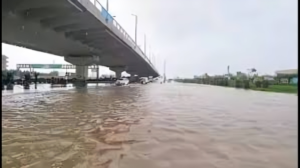Gurugram Drowns in Rainwater Chaos: Blame Game Unfolds
A sudden deluge left Gurugram streets turning into rivers, homes flooded, and daily life in shambles. As water rose rapidly, residents scrambled to safety, while officials were accused of ignoring warning signs. This article explores what went wrong, how people coped, and lessons for the future.

Why Gurugram Flooded So Fast
Gurugram’s rapid growth meant concrete everywhere. No proper drains, no green cover to absorb rain. When heavy rain hit:
- Water had nowhere to go and pooled on roads.
- Old drainage lines choked with garbage.
- Low-lying colonies became instant lakes.
People woke up to ankle-deep water outside their doors. Cars stalled, pumps failed, and electricity went off in many areas. Commuters stuck, shops closed, and local markets suffered huge losses.
Official Negligence or Natural Fury?
Local BJP chief pointed fingers at civic bodies, calling it “utter negligence.” He said:
- No timely cleaning of nullahs and drains.
- No proper warning or evacuation plan.
- Failure to maintain storm-water infrastructure.
However, officials claimed the rain was “unprecedented.” They argued that even best-built cities would strain under such downpour. Yet, many experts say:
- Climate change predictions warned of heavier monsoon rains.
- Urban planning ignored natural waterways.
- Regular maintenance was skipped to save costs.
Real-life story: Mrs. Sharma in Sector 14 lost her two-wheeler when water gushed into her garage at 3 AM. She says officials never came to inspect the clogged drain outside her home.
How Residents Fought Back
In adversity, communities rose up:
- Youth groups used sandbags to block water entry.
- Local temples opened doors to shelter affected families.
- Volunteers formed WhatsApp groups to share safe routes and relief spots.
Mr. Verma, a local shopkeeper, shifted his stock to an improvised raised platform. He offered dry snacks to stranded neighbours free of cost, showcasing true human spirit. Small acts of kindness made a big difference.
What Needs to Change
Long-term fixes must go hand in hand with quick action:
- Upgrade Drainage: Bigger pipes, regular de-siltation drives, clear garbage protocols.
- Green Cover: Plant more trees, create rain-gardens in parks and open spaces.
- Community Alert System: SMS and loudspeaker alerts before heavy downpour.
- Accountability: Transparent audits of civic maintenance funds; fast action on public complaints.
Governance should be people-first. Regular mock-drills, clear evacuation plans, and responsive helplines can save lives.

Conclusion: Turning Crisis into Opportunity
Gurugram’s rain crisis was a wake-up call. Neglect and rapid urbanisation amplified the damage, but community resilience shone through. By learning from this event, strengthening infrastructure, and fostering citizen-official collaboration, Gurugram can be ready for future storms.
Every storm passes, but the lessons we build must last. Together, we can transform chaos into a blueprint for safer, smarter cities.
#TRANDING
#TRANDING NEWS